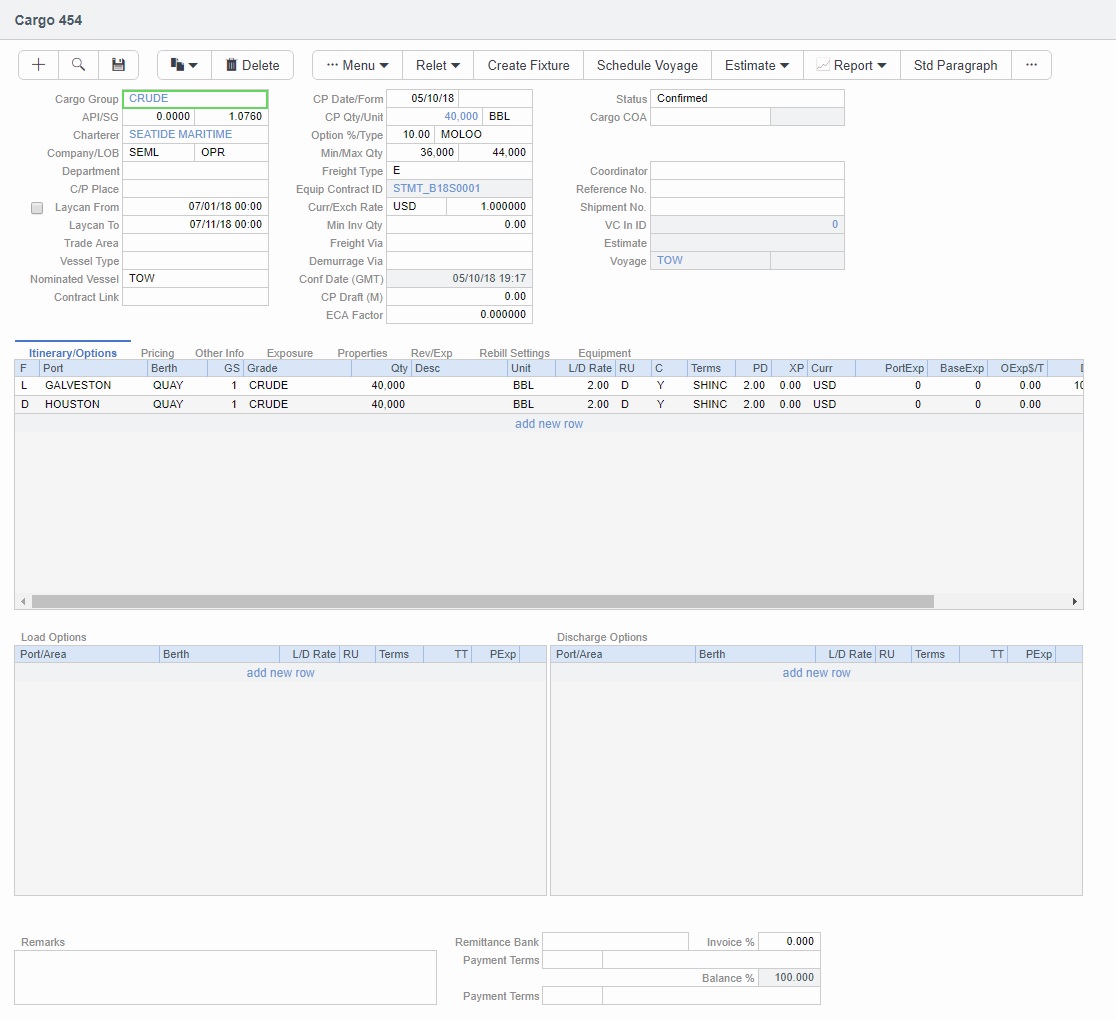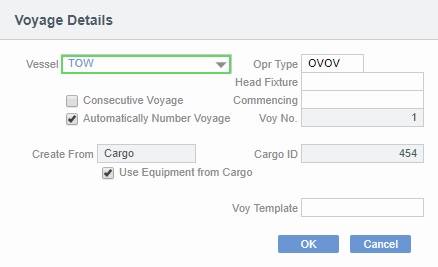IMOS - Barging - Chartering Workflow
Home > Barging > Chartering Workflow
Requires the Barging module.

This workflow applies to both Equipment TC Contracts and Equipment Spot Contracts:
The Charterer (moving Cargo inland) creates the cargo using the Cargo form.
If equipment and pricing are known, the Charterer can add these to the Equipment and Pricing tabs on the Cargo form.
The Charterer schedules the voyage. Equipment added to the Cargo flows to the voyage when the Use Equipment from Cargo check box is selected.
This section includes the following topics:
Create a Cargo
Create a new Cargo:

Specify a Cargo Group (with configuration flag Enable Multi Grade), Counterparty, CP Qty and Unit.
To enable equipment-based pricing on the Pricing tab, set the Freight Type to E.
Freight Type E stands for Equipment Daily Rate, and when selected, additional Equipment-related fields are available.
If the Freight Type is not set to E and the voyage is already scheduled, changing the Freight Type to E will back-create a Spot Equipment Contract.
In the Nominated Vessel field, select the name of the tow you want to link to this cargo. When a tow is selected, the Equipment tab appears on the form.
On the Itinerary tab, specify Loading and Discharging ports, Quantities, and other relevant information.
Add Equipment
On the Cargo Equipment tab, you can add boats and barges and their Equipment Contract IDs, if you know them, before scheduling the voyage. The Equip Rate, Rate Diff, and Diff fields are populated from the values entered on the Equipment Contract.

Note: The fields on this tab are used for reference. Any equipment you add here can be copied to the Equip In/Out tab on the Activity Log when the voyage is scheduled, and it is on that form where Operators manage equipment for the voyage.
Specify Pricing
You must specify the rates:
You are charging the Charterer for an Equipment TC Contract
You will pay to the Owner for an Equipment Spot Contract

On the Pricing tab:
Create a line for each Equipment Type, add the Number of Equipment, and Daily Rates.
If this is a consecutive voyage, you do not have to add this information to the next voyage, because the equipment is copied to the new voyage from the previous voyage.
Save the Cargo. The Equipment Contract ID field is populated with a generated ID number, but the contract is not created yet. The Equipment Contract is created when the voyage is scheduled, and at that time, you can open it.
Schedule the Voyage
To schedule the voyage, click Schedule Voyage on the Cargo form.

On the Create New Voyage form, some fields are completed. Complete the remaining fields according to the voyage.
Opr Type: Type of voyage being scheduled.
To create a Spot voyage/Equipment Spot Contract, select SPOT.
To create a TC voyage/Equipment TC Contract, select TCOV.
Cargoes with Freight Type E cannot be scheduled on TC tow voyages.
Consecutive Voyage: Select this check box if there is already a previous voyage for the vessel. The following apply:
The completing date of the previous voyage becomes the commencing date of the new voyage (displayed in the Commencing field).
The last port of the previous voyage becomes the commencing port of the next voyage.
The ending bunker inventory of the previous voyage becomes the beginning bunker inventory of the next voyage.
The Use Equipment from Cargo check box cannot be used when using the Consecutive Voyage check box because the equipment from end of the previous voyage is carried over.
If the voyage is based on an Equipment Contract, you cannot set up a consecutive voyage based on a TC Contract. However, if the first voyage is based on a TC Contract, you can create a consecutive voyage based an Equipment Contract.
Automatically Number Voyage: Select to automatically assign the next sequential voyage number for the vessel.
Using configuration flags, voyages can be configured to have voyages automatically numbered in these ways:
In sequence from the last voyage number
Based on the current year plus a 2- or 3-digit sequential number. For example, in 2013, the first voyage for each vessel would be either 1301 or 13001.
With a unique Voyage Number across the entire database, rather than for a particular vessel. Each new voyage is assigned the next open sequential number.
With a unique Voyage Number for voyages of Operation Types SPOT, RELT, and COAS.
Create From: The source is selected; upon voyage creation, the source data is included in the new voyage.
Use Equipment from Cargo: Selected by default for non-consecutive voyages. When selected, the equipment entered on the Equipment tab of the Cargo form is copied over to the voyage and appears on the Activity Log.
After the voyage is scheduled, the Operator manages the voyage.
